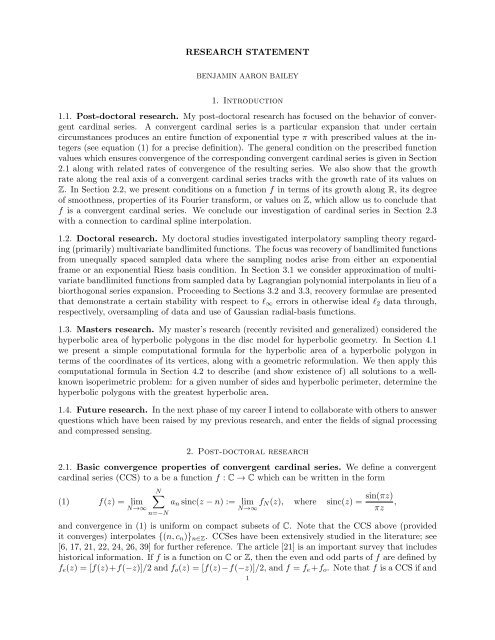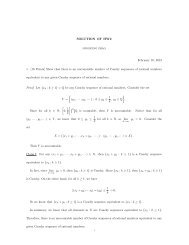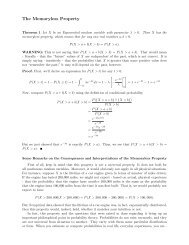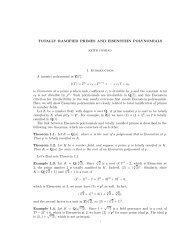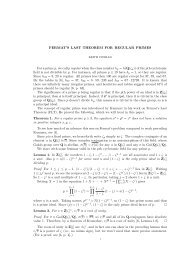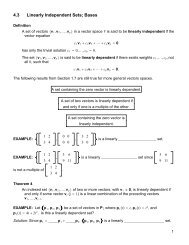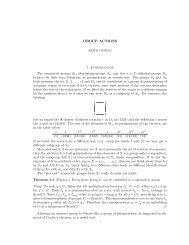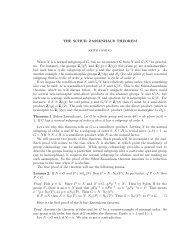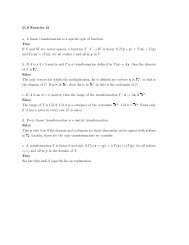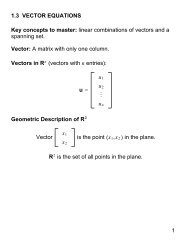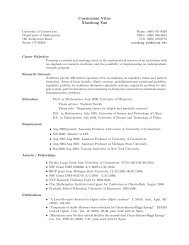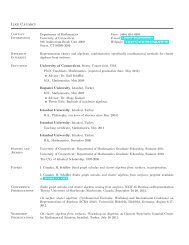Research Statement (pdf) - Department of Mathematics
Research Statement (pdf) - Department of Mathematics
Research Statement (pdf) - Department of Mathematics
You also want an ePaper? Increase the reach of your titles
YUMPU automatically turns print PDFs into web optimized ePapers that Google loves.
RESEARCH STATEMENT<br />
BENJAMIN AARON BAILEY<br />
1. Introduction<br />
1.1. Post-doctoral research. My post-doctoral research has focused on the behavior <strong>of</strong> convergent<br />
cardinal series. A convergent cardinal series is a particular expansion that under certain<br />
circumstances produces an entire function <strong>of</strong> exponential type π with prescribed values at the integers<br />
(see equation (1) for a precise definition). The general condition on the prescribed function<br />
values which ensures convergence <strong>of</strong> the corresponding convergent cardinal series is given in Section<br />
2.1 along with related rates <strong>of</strong> convergence <strong>of</strong> the resulting series. We also show that the growth<br />
rate along the real axis <strong>of</strong> a convergent cardinal series tracks with the growth rate <strong>of</strong> its values on<br />
Z. In Section 2.2, we present conditions on a function f in terms <strong>of</strong> its growth along R, its degree<br />
<strong>of</strong> smoothness, properties <strong>of</strong> its Fourier transform, or values on Z, which allow us to conclude that<br />
f is a convergent cardinal series. We conclude our investigation <strong>of</strong> cardinal series in Section 2.3<br />
with a connection to cardinal spline interpolation.<br />
1.2. Doctoral research. My doctoral studies investigated interpolatory sampling theory regarding<br />
(primarily) multivariate bandlimited functions. The focus was recovery <strong>of</strong> bandlimited functions<br />
from unequally spaced sampled data where the sampling nodes arise from either an exponential<br />
frame or an exponential Riesz basis condition. In Section 3.1 we consider approximation <strong>of</strong> multivariate<br />
bandlimited functions from sampled data by Lagrangian polynomial interpolants in lieu <strong>of</strong> a<br />
biorthogonal series expansion. Proceeding to Sections 3.2 and 3.3, recovery formulae are presented<br />
that demonstrate a certain stability with respect to l ∞ errors in otherwise ideal l 2 data through,<br />
respectively, oversampling <strong>of</strong> data and use <strong>of</strong> Gaussian radial-basis functions.<br />
1.3. Masters research. My master’s research (recently revisited and generalized) considered the<br />
hyperbolic area <strong>of</strong> hyperbolic polygons in the disc model for hyperbolic geometry. In Section 4.1<br />
we present a simple computational formula for the hyperbolic area <strong>of</strong> a hyperbolic polygon in<br />
terms <strong>of</strong> the coordinates <strong>of</strong> its vertices, along with a geometric reformulation. We then apply this<br />
computational formula in Section 4.2 to describe (and show existence <strong>of</strong>) all solutions to a wellknown<br />
isoperimetric problem: for a given number <strong>of</strong> sides and hyperbolic perimeter, determine the<br />
hyperbolic polygons with the greatest hyperbolic area.<br />
1.4. Future research. In the next phase <strong>of</strong> my career I intend to collaborate with others to answer<br />
questions which have been raised by my previous research, and enter the fields <strong>of</strong> signal processing<br />
and compressed sensing.<br />
2. Post-doctoral research<br />
2.1. Basic convergence properties <strong>of</strong> convergent cardinal series. We define a convergent<br />
cardinal series (CCS) to a be a function f : C → C which can be written in the form<br />
(1) f(z) = lim<br />
N∑<br />
N→∞<br />
n=−N<br />
a n sinc(z − n) := lim f N(z), where sinc(z) = sin(πz) ,<br />
N→∞ πz<br />
and convergence in (1) is uniform on compact subsets <strong>of</strong> C. Note that the CCS above (provided<br />
it converges) interpolates {(n, c n )} n∈Z . CCSes have been extensively studied in the literature; see<br />
[6, 17, 21, 22, 24, 26, 39] for further reference. The article [21] is an important survey that includes<br />
historical information. If f is a function on C or Z, then the even and odd parts <strong>of</strong> f are defined by<br />
f e (z) = [f(z)+f(−z)]/2 and f o (z) = [f(z)−f(−z)]/2, and f = f e +f o . Note that f is a CCS if and<br />
1
2<br />
only if f o and f e are both CCSes. The set <strong>of</strong> entire functions f which satisfy |f(z)| ≤ M ɛ e (σ+ɛ)|z|<br />
is denoted by E σ , the functions <strong>of</strong> exponential type σ. For convenience we consider σ = π.<br />
Theorem 2.1 below (a consolidation <strong>of</strong> Theorems from [6]) presents necessary and sufficient conditions<br />
on a sequence {c n } n∈Z so that some CCS f interpolates {(n, c n )} n∈Z , a rate <strong>of</strong> convergence<br />
<strong>of</strong> f N to f, and bounds on the growth <strong>of</strong> the resulting function f.<br />
Theorem 2.1 (B, Madych). Suppose {c n } n∈Z ⊂ C is a sequence with even and odd parts {a n } n∈Z<br />
and {b n } n∈Z .<br />
1) {f N } N∈N converges uniformly on compact subsets <strong>of</strong> C to an entire function f if and only if both<br />
∞∑<br />
(−1) n a n<br />
∞<br />
n 2 , and ∑<br />
(−1) n b n<br />
n<br />
converge.<br />
n=1<br />
2) Let f be a CCS. If K ⊂ C is compact, there exists M > 0 such that<br />
∣ ∞∑ ∣∣∣∣∣<br />
sup |f e (z)−f e,N (z)| ≤ M sup<br />
(−1) j a j<br />
z∈K<br />
n≥N ∣ j 2 and sup |f o (z)−f o,N (z)| ≤ M sup<br />
z∈K<br />
n≥N ∣<br />
3) If f is a CCS, then<br />
In particular, f ∈ E π .<br />
j=n+1<br />
n=1<br />
|f e (z)|e −π|Im(z)| = o(|z| 2 ) and |f o (z)|e −π|Im(z)| = o(|z|) as |z| → ∞.<br />
∞∑<br />
j=n+1<br />
(−1) j b j<br />
j<br />
2.2. Uniqueness <strong>of</strong> convergent cardinal series. Theorem 2.2 (see [9]), Corollary 2.3, and Theorem<br />
2.7, (a generalization <strong>of</strong> Theorem 5 in [6]), present conditions on f ∈ E π which allow us to<br />
conclude that f is a CCS.<br />
Theorem 2.2 below, (a partial converse <strong>of</strong> item 3) in Theorem 2.1) provides a wide class <strong>of</strong><br />
unbounded functions in E π which are CCSes.<br />
Theorem 2.2 (B, Madych). The following are true.<br />
1) Let f ∈ E π be odd. If lim x→∞ f (n) (x) = 0 for some n ≥ 0 and f(k) = o(k) as k → ∞ over the<br />
integers, then f is a CCS.<br />
f<br />
2) Let f ∈ E π be even. If lim (n) (x)<br />
x→∞ x<br />
= 0 for some n ≥ 0 and f(k) = o(k 2 ) as k → ∞ over the<br />
integers, then f is a CCS.<br />
Theorem 2.2 has the following corollary.<br />
Corollary 2.3 (B, Madych). Let f ∈ E π .<br />
1) If f e (x) = o(|x|) and f o (x) = o(1) as |x| → ∞, then f is a CCS.<br />
2) If lim |x|→∞ f(x) = 0, then f is a CCS.<br />
3) Let f (n)∣ ∣<br />
R<br />
∈ L p (R) for some 1 < p < ∞ and n ≥ 0. If f o (k) = o(k) and f(k) = o(k 2 ) as k → ∞,<br />
then f is a CCS.<br />
Item 2) in Corollary 2.3 is <strong>of</strong> particular interest, being a partial extension <strong>of</strong> a theorem <strong>of</strong><br />
Plancherel and Polya in [26, page 152]. Counterexamples may be found in [9] which show item 2)’s<br />
limitations as a generalization.<br />
Theorem 2.4 (a version <strong>of</strong> which appears in [8]) follows somewhat quickly from Corollary 2.3.<br />
Theorem 2.4 (B, Madych). Let h ∈ L 1 [−π, π], and define<br />
f(z) = z<br />
∫ π<br />
−π<br />
h(ξ)e iξz dξ.<br />
The function f is a CCS if and only if the Fourier series for h(ξ) + h(−ξ) converges at ξ = π.<br />
∣ .
Theorem 2.4 has the following corollaries. Corollary 2.5 appears in [8], and Corollary 2.6 originates<br />
in [6] as a stand-alone result with a different pro<strong>of</strong>.<br />
Corollary 2.5 (B, Madych). Let σ < π. If f ∈ E σ satisfies f(x)/x ∈ L 2 (R), then f is a CCS.<br />
Corollary 2.6 (B, Madych). Let µ be a bounded Borel measure on [−π, π], and define<br />
∫<br />
f(z) = e izξ dµ(ξ) for all z ∈ C.<br />
[−π,π]<br />
The function f can be expressed as follows:<br />
f(z) = i[µ{π} − µ{−π}] sin(πz) + lim<br />
N∑<br />
N→∞<br />
n=−N<br />
f(n)sinc(z − n).<br />
Corollary 2.6 may be generalized to Theorem 2.7, which is notable for its multidimensional<br />
nature.<br />
Theorem 2.7 (B). For z = (z 1 , · · · , z d ) ∈ C d , define SINC(z) = sinc(z 1 ) · . . . · sinc(z d ). Let µ be a<br />
bounded Borel measure on [−π, π] d , and define<br />
∫<br />
f(z) = e i(z 1ξ 1 +...+z d ξ d ) dµ(ξ) for all z = (z 1 , · · · , z d ) ∈ C d .<br />
[−π,π] d<br />
For each z ∈ C d , the limit<br />
exists, and<br />
S f (z) := lim<br />
∑<br />
N→∞<br />
‖n‖ ∞≤N<br />
f(n)SINC(z − n)<br />
|f(z) − S f (z)| ≤ 2e π(|Im(z 1)|+···+|Im(z d )|) |µ|(∂([−π, π] d )).<br />
Consequently, if µ is supported on (−π, π) d , then f(z) = S f (z) for all z ∈ C d .<br />
2.3. Splines and convergent cardinal series. Let L k (x) be the fundamental spline <strong>of</strong> order 2k<br />
that interpolates {(n, δ n0 )} n∈Z . L k satisfies<br />
(2) lim k(x) = sinc(x)<br />
k→∞<br />
when x ∈ R.<br />
Define the spline<br />
N∑<br />
(3) S k (x) = lim c n L k (x − n).<br />
N→∞<br />
n=−N<br />
For certain classes <strong>of</strong> functions f ∈ E π , (see [33, 34, 36]), equation (3) converges when c n = f(n),<br />
and<br />
lim<br />
k→∞ S k(x) = f(x).<br />
While the cited classes <strong>of</strong> functions are not necessarily CCSes, they do not contain all CCSes.<br />
However, in light <strong>of</strong> equation (2) and the form <strong>of</strong> equation (3), it is reasonable to expect that (3)<br />
holds when f is a CCS. This is exactly the content <strong>of</strong> Theorem 2.8 in [7].<br />
Theorem 2.8 (B, Madych). If f is CCS and S k is a spline <strong>of</strong> order 2k which both interpolate the<br />
data {(n, f(n))} n∈Z , then f(x) = lim k→∞ S k (x) uniformly on compact subsets <strong>of</strong> R.<br />
See [28, 31, 37, 35, 34] for other results regarding spline summability and its extensions.<br />
3. Doctoral research<br />
Let E ⊂ R d be Lebesgue measurable. P W E denotes the set <strong>of</strong> functions in L 2 (R d ) whose Fourier<br />
transform F(f) is zero a.e. in R d \ E.<br />
3
4<br />
3.1. { Multivariate bandlimited functions and Lagrangian polynomial interpolation. Let<br />
e<br />
i〈(·),t } n〉<br />
be a Riesz basis for L<br />
n∈Z d 2 ([−π, π] d ). Any f ∈ P W [π,π] d can be recovered from the<br />
sample values {f(t n )} n∈Z d by expanding against an associated Riesz basis, each element <strong>of</strong> which is<br />
an infinite product which is not computational in nature ( see [27, Chapter 4], [30], and [32]). Theorem<br />
3.2 investigates when any f ∈ P W [−π,π] d can be concretely approximated using multivariate<br />
polynomial interpolants. For this we require the notion <strong>of</strong> a uniformly invertible Riesz basis (see<br />
[3]).<br />
Definition 3.1. For each l ≥ 1, let C l,d = {−l, · · · , l} d . Let {t n } n∈Z d ⊂ R d . A sequence<br />
{<br />
e<br />
i〈(·),t } n〉<br />
is a uniformly invertible Riesz basis (UIRB) for L<br />
n∈Z d 2 ([−π, π] d ) if the following two<br />
conditions are satisfied.<br />
1) For each l ≥ 0, the sequence {f l,n } n∈Z d = { e i〈(·),tn〉} ∪ { e i〈(·),n〉} is a Riesz basis<br />
n∈C l,d n∈Z d \C l,d<br />
for L 2 ([−π, π] d ). That is, the map L l<br />
(<br />
e<br />
i〈(·),n〉 ) = f l,n is an onto isomorphism.<br />
2) sup l≥0 ‖L −1<br />
l<br />
‖ < ∞.<br />
The following are examples <strong>of</strong> UIRBs:<br />
1) When d = 1 and lim sup |n|→∞ |t n − n| < 1/4, the sequence { e itn(·)} n∈Z is a UIRB for L 2[−π, π].<br />
It is a classic result that { e itn(·)} Riesz bases (see [25]).<br />
n∈Z<br />
2) When d > 1 and sup n∈Z d ‖t n − n‖ ∞ < ln(2)<br />
πd , the sequence { e i〈(·),tn〉} is a UIRB for<br />
n∈Z d<br />
L 2 ([−π, π] d ). The fact that { e i〈(·),tn〉} is Riesz basis follows from results in [1].<br />
n∈Z d<br />
Before stating Theorem 3.2 (proven in [3]), we need a definition. For x ∈ R d , define<br />
Q d,l (x) =<br />
l∏<br />
k 1 =1<br />
( )<br />
1 − x2 1<br />
k1<br />
2<br />
· . . . ·<br />
l∏<br />
k d =1<br />
( )<br />
1 − x2 d<br />
kd<br />
2 .<br />
Theorem 3.2 (B). Let {t n } n∈Z d ⊂ R d be a sequence such that { e i〈(·),tn〉} n∈Z d is a UIRB for<br />
L 2 ([−π, π] d ). The following are true.<br />
1) For all f ∈ P W [−π,π] d, there exists a unique sequence <strong>of</strong> polynomials {Ψ l } l∈N<br />
such that Ψ l :<br />
R d → R has coordinate degree at most 2l, and Ψ l (t n ) = f(t n ) for all n ∈ C l,d .<br />
2) If f ∈ P W [−π,π] d where {Ψ l } is the sequence <strong>of</strong> interpolating polynomials from 1), then<br />
f(t) = lim<br />
l→∞<br />
Ψ l (t) SINC(t)<br />
Q d,l (t)<br />
where the limit exists in both L 2 (R d ) and L ∞ (R d ) metrics.<br />
uniformly on compact subsets <strong>of</strong> R d .<br />
In particular, f(t) = lim l→∞ Ψ l (t)<br />
3.2. Oversampling and recovery <strong>of</strong> bandlimited functions from sampled data. The following<br />
theorem from [5] (motivated by [13] and [18] and generalized from results in [4]) presents a<br />
recovery formula from unequally spaced data nodes for a broad class <strong>of</strong> bandlimited functions. Under<br />
certain conditions on the sampling nodes, the recovery formula is stable under l ∞ perturbations<br />
in the sampled values.<br />
Theorem 3.3 (B). Let 0 ∈ E ⊂ R d be compact, symmetric about 0, and satisfy E ⊂ Int(βE) for<br />
all β > 1. Choose {t n } n∈N<br />
⊂ R d such that { e i〈(·),tn〉} n , is a frame for L 2(E) with frame operator<br />
S, and let λ 0 > 1.
1) There exists a rapidly decaying real-valued function g ∈ C ∞ (R d ) such that if λ ≥ λ 0 and<br />
f ∈ P W E ,<br />
(<br />
(4) f(t) = 1 ∑ ∑<br />
( ) ) (<br />
tn<br />
λ d B kn f g t − t )<br />
k<br />
, t ∈ R d ,<br />
λ<br />
λ<br />
k∈N n∈N<br />
where B kn = 〈S −1 f n , S −1 f k 〉 E . The sum converges with respect to the L 2 (R d ) and uniform metrics.<br />
2) Let {ɛ n } n∈N be a sequence <strong>of</strong> real numbers such that sup n |ɛ n | = ɛ < ∞, and B be the N × N<br />
matrix with the entries B kn in item 1). If B : l ∞ → l ∞ (interpreted as matrix multiplication) is<br />
well-defined, then<br />
(<br />
˜f(t) = 1 ∑ ∑<br />
( ) ]<br />
tn<br />
λ d B kn<br />
[f<br />
) (<br />
+ ɛ n g t − t )<br />
k<br />
, t ∈ R d<br />
λ λ<br />
k∈N n∈N<br />
converges, and there exists a real number M independent <strong>of</strong> f and ɛ such that ||f − ˜f|| L∞(R d ) ≤ Mɛ.<br />
In Theorem 3.3 if E = [−π, π] d , where { e i〈(·),tn〉} n∈N is a Riesz basis for L 2([−π, π] d ), we can<br />
replace B by a sequence <strong>of</strong> finite matrices and obtain a computationally manageable version <strong>of</strong><br />
equation (4). We omit this formula for the sake <strong>of</strong> brevity.<br />
3.3. Nonuniform sampling and Gaussian radial-basis functions. Theorem 3.4 below, (see<br />
[10]) gives a asymptotic recovery formula for a class <strong>of</strong> bandlimited functions involving Gaussian<br />
radial-basis functions.<br />
Theorem 3.4 (B, Schlumprecht, Sivakumar). Let B 2 be the closed unit ball in L 2 (R d ). Let Z ⊂ R d<br />
be convex and symmetric about the origin such that δB 2 ⊂ Z ⊂ B 2 for some δ ∈ ( √ 2/3, 1]. Let<br />
{t n } n∈N<br />
⊂ R d be a sequence such that { e 〈(·),tn〉} n∈N is a Riesz basis for L 2(Z). Given f ∈ P W B2 ,<br />
let f S = {f(t k )} k∈N<br />
. For λ > 0, define the N × N matrix A by A nm = e −λ‖tn−tm‖2 2 . The following<br />
statements hold:<br />
1) The map x ↦→ Ax from l 2 (N) to itself is linear, bounded, invertible, with bounded inverse.<br />
2) The map<br />
f ↦→ I λ (f) := ∑ n∈N(A −1 f S ) n e −λ‖(·)−tn‖2 2<br />
is bounded linear from P W Z to L 2 (R d ). Additionally, I λ (f) ∈ C 0 (R d ).<br />
3) Let 0 < β < √ 3δ 2 − 2. For all f ∈ P W βB2 , we have f = lim λ→0 + I λ (f) in L 2 (R d ) and uniformly<br />
on R d .<br />
Consider when d = 1 and Z = [−π, π]. In this case Theorem 3.4 enjoys a strong stability property.<br />
If we reindex all terms in Theorem 3.4 by Z, then the entries <strong>of</strong> A −1 satisfy |A −1<br />
n,m| ≤ Me −α|n−m|<br />
for some M, α > 0. This implies that A −1 is l ∞ → l ∞ continuous, so we have stability <strong>of</strong> I λ (f)<br />
given l ∞ perturbations <strong>of</strong> the sampled data. It is not known to the author whether Riesz bases<br />
for L 2 (B 2 ) exist. It is known however that Riesz bases consisting <strong>of</strong> exponentials exist for L 2 (P)<br />
where P is a filled convex symmetric polygon with an even number <strong>of</strong> sides (see [29]). There are<br />
certainly polygons Z <strong>of</strong> this type that satisfy the somewhat delicate conditions <strong>of</strong> Theorem 3.4.<br />
4. Master’s research<br />
The closed unit disc D ⊂ C endowed with the Poincaré metric density ds = 2<br />
1−|z| 2 |dz| is the disc<br />
model for hyperbolic geometry. The terms geodesic, hyperbolic arclength (h-length), and hyperbolic<br />
area (h-area) may be defined naturally in terms <strong>of</strong> the resulting metric, and the orientationpreserving<br />
isometries are the Möbius transformations from D onto itself, see [12]. A hyperbolic<br />
n-gon (h-n-gon) is a Jordan curve in D whose boundary consists <strong>of</strong> n geodesics.<br />
5
6<br />
4.1. The hyperbolic area formula. Theorem 4.1 below appears in [2].<br />
Theorem 4.1 (B). If (x n+1 , y n+1 ) := (x 1 , y 1 ), . . . , (x n , y n ) are the distinct positively oriented vertices<br />
<strong>of</strong> an h-n-gon, then the h-area <strong>of</strong> the h-n-gon is<br />
n∑<br />
( )<br />
(5) A = 2tan −1 xk y k+1 − y k x k+1<br />
.<br />
1 − x k x k+1 − y k y k+1<br />
k=1<br />
If the h-n-gon has l concave sides and m convex sides, with angle measures α k and β k respectively,<br />
then equation (5) takes the form<br />
(6) A =<br />
l∑<br />
α k −<br />
k=1<br />
m∑<br />
β k .<br />
Equation (6) compares favorably to the classical Gauss-Bonnet formula, and each can be used<br />
to prove the other.<br />
4.2. The isoperimetric theorem. Theorem 4.1 can be applied to prove the isoperimetric result<br />
below.<br />
Theorem 4.2 (B, unpublished). For each n ≥ 0, there exists an h-n-gon with h-perimeter P with<br />
maximal h-area. If (w 1 , . . . , w n ) are the vertices <strong>of</strong> any such h-n-gon, there is an isometry M, and<br />
R ∈ (0, 1) (depending only on P and n) such that<br />
( ) 2πik<br />
M(w k ) = R exp .<br />
n<br />
Versions <strong>of</strong> Theorem 4.2 (not all equivalent) have appeared elsewhere, see [11, 15, 16].<br />
k=1<br />
5. Questions for future research<br />
5.1. Questions relating to convergent cardinal series. We present the following reworded<br />
Theorem from [38].<br />
Theorem 5.1 (Seip). Let {t n } n∈Z be a real sequence such that<br />
(7) sup |t n − n| < 1/4.<br />
n∈Z<br />
Define the entire functions<br />
G(z) = (z − t 0 )<br />
∞∏<br />
n=1<br />
Let 0 < σ < π. For all f ∈ E σ ∩ L ∞ (R),<br />
(<br />
1 − z<br />
t n<br />
) (<br />
1 − z<br />
t −n<br />
)<br />
(8) f(t) = lim<br />
uniformly on compact subsets <strong>of</strong> R.<br />
N∑<br />
N→∞<br />
n=−N<br />
and H n (z) =<br />
f(t n )H n (t)<br />
G(z)<br />
G ′ (t n )(z − t n ) .<br />
Theorem 5.1 has the following statement as a corollary (which may also be deduced for Corollary<br />
2.5). Let 0 < σ < π. If f ∈ E σ ∩ L ∞ (R), then f is a CCS. This is certainly not true if σ = π;<br />
simply consider f(z) = sin(πz). If f ∈ E π ∩ L ∞ (R), it is unknown whether or not the CCS which<br />
interpolates {(n, f(n))} n∈Z always converges. A partial result in this direction is Theorem 5.2 from<br />
[9].
Theorem 5.2 (B, Madych). Let f ∈ E π .<br />
If f is bounded on R, there exists an increasing sequence <strong>of</strong> positive integers {N j } j∈N and a constant<br />
C such that<br />
f(z) = C sin(πz) + lim<br />
j→∞<br />
N j<br />
∑<br />
n=−N j<br />
f(n) sinc(z − n).<br />
In light <strong>of</strong> the corollary mentioned above, Theorem 5.2, and the function z ↦→ sin(πz), we ask<br />
the following question.<br />
1) If f ∈ E π ∩ L ∞ (R), when does there exist a constant C such that the equality below holds?<br />
f(z) = C sin(πz) + lim<br />
N∑<br />
N→∞<br />
n=−N<br />
f(n) sinc(z − n).<br />
It is well known that if {t n } is any real sequence such that {e i(·)tn } is a Riesz basis for L 2 [−π, π],<br />
then B = {sinc((·) − t n )} is a Riesz basis for P W [−π,π] . By [30] (which also develops the corresponding<br />
L p theory) and [32], B has a biorthogonal Riesz basis {H n (·)} with an infinite product<br />
expansion analogous to the expression given in Theorem 5.1. By Kadec’s ”1/4” Theorem in [25],<br />
the expansion (8) is the biorthogonal expansion for f ∈ P W [−π,π] . In this setting, Seip’s Theorem<br />
shows that a nontrivial expansion which lives most naturally in a Hilbert space is also valid in an<br />
L ∞ space! Taking these statements together, we ask the following question.<br />
2) Let 1 < p < ∞, and {t n } be a complete interpolating sequence for E π ∩ L p (R). In what spaces<br />
<strong>of</strong> entire functions <strong>of</strong> exponential type σ < π does the corresponding expansion analogous to (8)<br />
(as developed in [30]) hold?<br />
Multidimensional generalizations <strong>of</strong> Theorems 2.1 and 2.2 are also <strong>of</strong> interest.<br />
5.2. Questions relating to Theorem 3.2. Examples <strong>of</strong> UIRBs are given in Section 2, but no<br />
comprehensive characterization has been given. In [5], a more general concept <strong>of</strong> uniform invertibility<br />
is developed, so that given any Riesz basis {f n } n for separable Hilbert space, there exists<br />
an orthogonal basis (playing a role similar to that <strong>of</strong> { e i〈(·),n〉} presented here), such that<br />
n∈Z d \C l,d<br />
{f n } n is a UIRB with respect to that basis. The pro<strong>of</strong> is currently non-constructive, and given an<br />
exponential Riesz basis, it would be useful to have a construction <strong>of</strong> such a concrete orthogonal<br />
basis which is amenable to computation through the Fourier transform.<br />
3) If { e i〈(·),t k〉 } n∈Z d is a Riesz basis for L 2 ([−π, π] d ), when is it a UIRB?<br />
Multidimensional generalizations <strong>of</strong> Theorem 3.2 are also <strong>of</strong> interest.<br />
5.3. Questions relating to Theorem 3.3. There are unresolved issues regarding the matrix<br />
from Theorem 3.3.<br />
4) What are criteria for the infinite matrix B from Theorem 3.3 to be defined (and in this case<br />
necessarily bounded) as a map from l ∞ to itself?<br />
As a special case, what is the rate <strong>of</strong> decay <strong>of</strong> the entries <strong>of</strong> B <strong>of</strong>f the main diagonal, and how<br />
does this relate to the rate <strong>of</strong> decay <strong>of</strong> the entries <strong>of</strong> (B −1 ) nm = sincπ(t n −t m ) when B is invertible?<br />
Even when t n = n + δ n and δ n is small, the <strong>of</strong>f-diagonal decay <strong>of</strong> B −1 is somewhat pathological,<br />
and the following theorem doesn’t apply.<br />
7
8<br />
Theorem 5.3 (Jaffard, [23]). If A is boundedly invertible on l 2 (Z d ) and |a kl | = O(|k−l| −s ) for some<br />
s > d, then its inverse B = A −1 has the same polynomial-type <strong>of</strong>f-diagonal decay |b kl | = O(|k−l| −s ).<br />
Unfortunately, Corollary 11 in [20] (a generalization <strong>of</strong> Theorem 5.3) doesn’t appear to apply<br />
either, so the problem appears genuinely difficult.<br />
5.4. Questions relating to Theorem 3.4. The following variant <strong>of</strong> Theorem 3.4 was proven by<br />
Schlumprecht and Sivakumar, (see [37]).<br />
Theorem 5.4. Let {t n } n∈N ⊂ R be a sequence such that { e 〈(·),tn〉} n∈N is a Riesz basis for L 2([−π, π]).<br />
Given f ∈ P W [−π,π] , let f S = {f(t k )} k∈N . For A as defined in Theorem 3.4, and λ > 0, define<br />
The following statements hold:<br />
I λ (f)(·) = ∑ n∈N(A −1 f S ) n e −λ((·)−tn)2 .<br />
1) The map f ↦→ I λ (f) is bounded linear from P W [−π,π] to L 2 (R). Additionally, I λ (f) ∈ C 0 (R).<br />
2) For all f ∈ P W [−π,π] , we have f = lim λ→0 + I λ (f) in L 2 (R) and uniformly on R.<br />
Schlumprecht and Sivakumar have proven the d-dimensional version <strong>of</strong> Theorem 5.4 (unpublished)<br />
with [−π, π] replaced by B 2 , but in order to be non-vacuous, their generalization requires<br />
the existence <strong>of</strong> Riesz bases <strong>of</strong> exponentials for L 2 (B 2 ). For this reason we ask whether or not<br />
Theorem 5.4 holds in d-dimensions when {t n } n∈N ⊂ R d is chosen such that { e 〈(·),tn〉} is a frame<br />
n∈N<br />
for L 2 (B 2 ) instead <strong>of</strong> a Riesz basis. In this setting, Beurling has shown in [14] that exponential<br />
frames exist in abundance.<br />
5.5. A Question relating to Theorem 4.1. The pro<strong>of</strong> <strong>of</strong> Theorem 4.1 makes extensive use <strong>of</strong><br />
the geometry <strong>of</strong> Möbius transformations and standard integral theorems. The transformations in<br />
the analogous three dimensional model <strong>of</strong> hyperbolic geometry are quite similar in spirit (see [12])<br />
to their two dimensional cousins, though we no longer have a field structure to exploit. Suitably<br />
modified, the pro<strong>of</strong> <strong>of</strong> Theorem 4.1 should generalize to give a hyperbolic volume formula for<br />
hyperbolic polyhedra.<br />
References<br />
[1] B. A. Bailey, An asymptotic equivalence between two frame perturbation theorems, in: M. Neamtu, L. Schumaker<br />
(Eds.), Proceedings <strong>of</strong> Approximation Theory XIII: San Antonio 2010, Springer pp. 1-7.<br />
[2] B. A. Bailey, Area <strong>of</strong> polygons in hyperbolic geometry, Masters thesis, Texas Tech University <strong>Department</strong> <strong>of</strong><br />
<strong>Mathematics</strong> and Statistics, (2004).<br />
[3] B. A. Bailey, Multivariate polynomial interpolation and sampling in Paley-Wiener spaces, J. Approx. Theory 164<br />
(2012), no. 4, 460-487.<br />
[4] B. A. Bailey, Sampling and recovery <strong>of</strong> multidimensional bandlimited functions via frames, J. Math. Anal. App.<br />
370 (2010), no. 2, 374-388.<br />
[5] B. A. Bailey, Studies in interpolation and approximation <strong>of</strong> multivariate bandlimited functions, Doctoral dissertation,<br />
Texas A&M University <strong>Department</strong> <strong>of</strong> mathematics, (2011).<br />
[6] B. A. Bailey, W. R. Madych, Convergence <strong>of</strong> Classical Cardinal Series and Band Limited Special Functions, J.<br />
Fourier. Anal. Appl. DOI 10.1007/s00041-013-9291-4.<br />
[7] B. A. Bailey, W. R. Madych, Convergence and summability <strong>of</strong> cardinal sine series, in preparation.<br />
[8] B. A. Bailey, W. R. Madych, Convergence, uniqueness, and the cardinal sine series, Proceedings <strong>of</strong> SampTA13,<br />
the 10th International Conference on Sampling Theory and Applications, Bremen, Germany, July 1-5, 2013,<br />
submitted.<br />
[9] B. A. Bailey, W. R. Madych, Functions <strong>of</strong> exponential type and the cardinal series, submitted to J. Approx.<br />
Theory (2013) under review.<br />
[10] B. A. Bailey, Th. Schlumprecht, N. Sivakumar, Nonuniform sampling and recovery <strong>of</strong> multidimensional bandlimited<br />
functions by Gaussian radial basis functions, J. Fourier Anal. Appl. 17 (3) (2011), 519-533.<br />
[11] Roger W. Barnard, Petros Hadjicostas, Alexander Yu. Solynin, The Poincaré metric and isoperimetric inequalities<br />
for hyperbolic polygons, Trans. Amer. Math. Soc. 357 (2005), 3905-3932.
[12] Alan F. Beardon, The Geometry <strong>of</strong> Discrete Groups, New York, Springer-Verlag, 1983.<br />
[13] J. Benedetto, Irregular sampling and frames, Wavelets - A Tutorial in Theory and Applications, (1991) 1-63.<br />
[14] A. Beurling, Local harmonic analysis with some applications to differential operators, “Some Recent Advances<br />
in the Basic Sciences, Vol. 1” (Proc. Annual Sci. Conf., Belfer Grad. School Sci., Yeshiva Univ., New York,<br />
1962–1964) (1966) 109-125.<br />
[15] K. Bezdek, Ein elementarer Beweis für die isoperimetrische Ungleichung in der Euklidischen und hyperbolischen<br />
Ebene, Ann. Univ. Sci. Budapest. de Rolando Eötvös Sect. Math. 27 (1985), 107-112.<br />
[16] Balázs Ciskos, Zsolt Lángi, Márton Naszodi, A generalization <strong>of</strong> the discrete isoperimetric inequality for piecewise<br />
smooth curves <strong>of</strong> constant geodesic curvature, Period. Math. Hungar. 53 1-2 (2006), 121-131.<br />
[17] P. L. Butzer, J. R. Higgins, R. L. Stens, Classical and approximate sampling theorems: studies in the L P (R)<br />
and the uniform norm, J. Approx. Theory 137 (2005), no. 2, 250-263.<br />
[18] I. Daubechies, R. DeVore, Approximating a bandlimited function using very coarsely quantized data: a family<br />
<strong>of</strong> stable sigma-delta modulators <strong>of</strong> arbitrary order, Ann. <strong>of</strong> Math. (2003) 679-710.<br />
[19] Do Carmo, M. P., Differential Geometry <strong>of</strong> Curves and Surfaces, Upper Saddle River, New Jersey, Prentice-Hall<br />
Inc., 1976.<br />
[20] K. Groëchnig, M. Leinert, Symmetry and inverse closedness <strong>of</strong> matrix algebras and functional calculus for infinite<br />
matrices, Trans. Amer. Math. Soc. (2006) 2695-2711.<br />
[21] J. R. Higgins, Five short stories about the cardinal series, Bull. Amer. Math. Soc. (N.S.) 12(1985), no. 1, 45-89.<br />
[22] J. R. Higgins, Sampling Theory in Fourier and Signal Analysis: Foundations, Oxford Science Publications,<br />
Clarendon Press, Oxford, 1996.<br />
[23] S. Jaffard, Propriétés des matrices “bien localisées” près de leur diagonale et quelques applications, Ann. Inst.<br />
H. Poincaré Anal. Non Linéare (1990), 461-476.<br />
[24] A. J. Jerri, The Shannon sampling theorem-its various extensions and applications: a tutorial review, Proc.<br />
IEEE 65 (11) (1977) 1565-1596.<br />
[25] M. I. Kadec, The exact value <strong>of</strong> the Paley-Wiener constant, Sov. Math. Dokl. (1964) 559-561.<br />
[26] B. Ya. Levin, Lectures on entire functions, In collaboration with and with a preface by Yu. Lyubarskii, M.<br />
Sodin and V. Tkachenko. Translated from the Russian manuscript by Tkachenko. Translations <strong>of</strong> Mathematical<br />
Monographs, 150. American Mathematical Society, Providence, RI, 1996.<br />
[27] N. Levinson, Gap and Density Theorems, American Mathematical Society, (1940).<br />
[28] Yu. Lyubarskii and W. R. Madych, The recovery <strong>of</strong> irregularly sampled band limited function via tempered<br />
splines, J. Funct. Anal. 125 (1994), no. 1, 201-222.<br />
[29] Y. I. Lyubarskii, A. Rashkovskii, Complete interpolating sequences for Fourier transforms supported by convex<br />
symmetric polygons, Ark. Math. (2000) 130-170.<br />
[30] Yu. Lyubarskii, K. Seip, Complete interpolating sequences for Paley-Wiener spaces and Muckenhoupt’s (A p)<br />
condition, Rev. Mat. Iberoamericana (1997) 361-376.<br />
[31] W. R. Madych, Summability <strong>of</strong> Lagrange tpe interpolation series, J. Anal. Math. 84 (2001) 207-229.<br />
[32] B. S. Pavlov, The basis property <strong>of</strong> a system <strong>of</strong> exponentials and the condition <strong>of</strong> Muckenhoupt, Dokl. Acad.<br />
Nauk (1979) 37-40.<br />
[33] I. J. Schoenberg, Cardinal spline interpolation, Conference Board <strong>of</strong> the Mathematical Sciences Regional Conference<br />
Series in Applied <strong>Mathematics</strong>, No. 12. Society for Industrial and Applied <strong>Mathematics</strong>, Philadelphia,<br />
Pa., 1973. vi+155 pp.<br />
[34] I. J. Schoenberg, Cardinal interpolation and spline functions. VII. The behavior <strong>of</strong> cardinal spline interpolants<br />
as their degree tends to infinity, J. Analyse Math. 27 (1974) 205-229.<br />
[35] I. J. Schoenberg, Notes on spline functions. III. On the convergence <strong>of</strong> the interpolating cardinal spline interpolants<br />
as their degree tends to infinity, J. Analyse Math. 16 (1973) 87-93.<br />
[36] I. J. Schoenberg, On the remainders and the convergence <strong>of</strong> cardinal spline interpolation for almost periodic<br />
functions, Sudeis in spline functions and approximation theory, Academic Press, New York, (1976) 277-303.<br />
[37] Th. Schlumprecht, N. Sivakumar, On the sampling and recovery <strong>of</strong> bandlimited functions via scattered translates<br />
<strong>of</strong> the Gaussian, J. Math. Anal. Appl. 159 (2009), no. 1, 128-153.<br />
[38] K. Seip, An irregular sampling theorem for functions bandlimited in a generalized sense, SIAM Journal on<br />
Applied <strong>Mathematics</strong>, 47 (Oct., 1987), No. 5, 1112-1116.<br />
[39] G. G. Walter and X. Shen, Wavelets and other orthogonal systems, 2nd ed. Studies in Advanced <strong>Mathematics</strong>.<br />
Chapman and Hall/CRC, Boca Raton, FL, 2001.<br />
9


